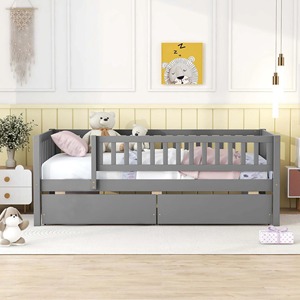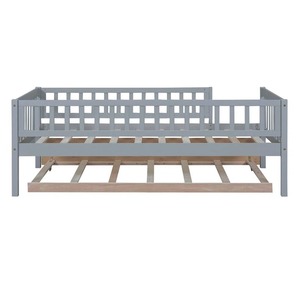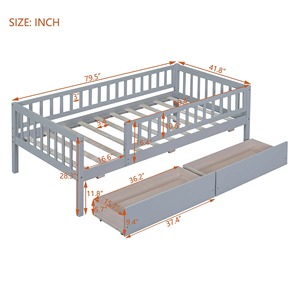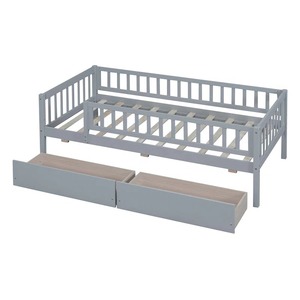
All categories
Featured selections
Trade Assurance
Buyer Central
Help Center
Get the app
Become a supplier

(5445 products available)














































There are several types of solid wood baby cribs available. Each type has its unique features and benefits. Here are the most common types:
Convertibility:
The flexibility of solid wood baby cribs is one of their most important features. These cribs are built to last through all the stages of a child's development and can be converted into different forms. For example, a convertible crib can be changed into a toddler bed or a daybed, which helps to prolong its usefulness. This change not only saves money but also makes sure that the same sturdy and safe sleeping environment is provided for the child as they grow.
Adjustable Mattress Height:
Solid wood baby cribs have adjustable mattress heights, making them easy to use and safe. When the baby is still very small, the mattress can be placed at a higher level, which makes it easy for the parents to pick the baby up. As the baby grows and learns to stand up, the mattress is lowered to make the crib more secure and prevent climbing out. This feature ensures that the baby is comfortable and has enough space to sleep.
Durability and Stability:
Wooden cribs for babies are a reliable choice for long-lasting baby furniture because of their strength. Solid wood is used to build these cribs, which include oak, maple, and birch. These woods are known for their strength and stability. A baby's crib made of solid wood can handle rough treatment from active toddlers who love to climb and pull up on things as they get older and more mobile.
Non-Toxic Finishes:
The health and safety of babies are taken care of by solid wood baby cribs that are built with non-toxic finishes. These finishes shield the wood and give a smooth surface, making them easy to clean and maintain. Since babies spend a lot of time in their cribs, it is very important to choose cribs with non-toxic finishes that will not release harmful chemicals into the air or pose a risk of exposure through chewing.
Classic Aesthetic:
Baby cribs made of solid wood are stylish and elegant, which makes them a popular choice among parents. They have a warm, natural beauty that adds a touch of sophistication to any nursery. Whether it is a sleek, modern design or a rustic, distressed finish, there is a solid wood crib to match every parent's style and taste. These cribs can also be passed down through generations because of their timeless quality.
Solid wood baby cribs are used in different ways. Below are some of them:
Below are some of the considerations when choosing a solid wood baby crib for resale:
Safety Standards
Check whether the crib has any certifications, which show it meets safety standards. The certification ensures the crib is safe for the baby and a suitable product for resale.
Wood Type
Invest in cribs made of durable wood types, such as oak or maple wood. Solid wood baby cribs are more durable than those made of engineered wood. Choose a crib with high-quality wood to ensure the crib lasts longer and can be resold at a good price.
Finish
Choose a crib with a non-toxic finish. A non-toxic finish ensures the baby is not exposed to harmful chemicals that may be in the crib's solid wood natural finish. The finish also affects the resale value and attractiveness of the solid wood baby crib.
Construction
The construction quality of the crib will determine its durability and stability. Choose a crib that is well-constructed with high-quality materials. A crib with solid construction will be stable and safe for the baby.
Adjustable Mattress Height
Choose a solid wood baby crib with an adjustable mattress height. An adjustable mattress height allows parents to raise the mattress when the baby is younger and lower it as the baby grows. Babies are safer in cribs with lower mattress heights.
Storage
Consider a crib with under-storage space. A storage space under the crib offers a convenient space to keep baby essentials. Choosing a solid wood crib with under-storage space is more beneficial than opting for a crib without storage space.
Q1: Can a solid wood baby crib be converted to a toddler bed?
A1: Yes, many solid wood cribs can be converted into toddler beds. These cribs usually have removable side rails that can be replaced with lower, rail-less toddler bed rails. This conversion is possible if the crib is not recalled and the conversion kit is available.
Q2: Can a solid wood baby crib be painted or stained?
A2: Cribs can be painted or stained, but only with baby-safe, non-toxic finishes. It is always advisable to check the manufacturer's recommendations before making any changes to the crib's finish.
Q3: At what age should a baby be transitioned out of a crib?
A3: There is no specific age at which a baby should be transitioned out of a crib. Most babies can be transitioned to a toddler bed when they are between 18 months and 3 years. Signs that a child is ready to transition include climbing out of the crib or when they start to hit their head against the crib.